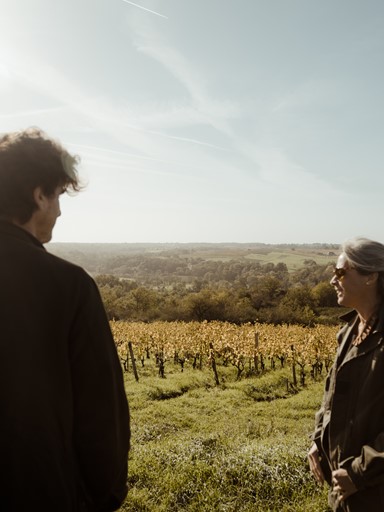
Terre de L'Élu
France, Loire
The Story
In 2008, Thomas and Charlotte Carsin found their dream domaine, Clos de L’Elu, a 20 hectare site in the Layon Valley near Chaume in the Western part of the Loire. They took over the existing domaine and began a slow but exhilarating process of transformation. They revitalised the vineyards, planted native grapes, experimented with alternate ageing vessels and ultimately crafted the exceptional wines of their dreams.
Though it was initially Chenin which drew them to Anjou, they rejected the sweeter styles typical of the area and focused on expressing the terroir through dry wines. But what really fascinated Thomas was the reds, “At the time, nobody was speaking of red wines here, but I wanted to try… and I found a way. And today we produce more reds than whites.”
Their Cabernet Francs offer notably different expressions of this grape, and their Pineau d’Aunis and Gamay wines have gained a loyal following.
In 2018, frustrated by politics and arbitrary restrictions of the appellation, they decided to leave the AOC. This meant more freedom to grow the grapes they wanted and vinify them as they wished, but also necessitated a name change, as they were no longer allowed to us any word referencing the location - including their famous walled Clos. So the domaine became Terre de L’Elu, the wines were labeled Vin de France, and a new era of experimentation and creativity began. Thomas affirms their decision with, “What counts the most is to make the wine of the terroir.”
The wines now truly reflect the couples’ ethos, and their signature expressive and rich style flourishes.
Click here to watch Thomas Carsin’s interview with 67 Pall Mall.
View Wines“We prefer to give priority to our freedom and creativity rather than trying to make wines that do not resemble us.”
The People
Thomas & Charlotte
While studying agriculture, Thomas discovered a passion for viticulture, eventually working as a consultant for nearly a decade in Provence, Champagne and California. After he met his wife Charlotte, the two began to dream of their own domaine. Their mutual love of the sea and their childhoods in Brittany pulled them back towards the Atlantic. They searched for land in the western part of the Loire and fell in love with Clos de L’Elu, an existing 20 hectare domaine overlooking the rolling hills of the Couteaux de Loire. Thomas says he “…was drawn to just the mere feeling of this land.”
In 2008, they purchased the domaine and began to reshape it per their desires. Thomas learned from local legends Damien Laureau and Patrick Baudouin. They established a thorough organic program, explored the possibilities of the terroir and began defining their own cuvées. By 2012, the couple were making a half dozen of their own wines, to critical and customer acclaim.
The work of managing the domaine is shared with a team of five like-minded assistants (and their adorable dog Feydeau), but it is the talents of Charlotte and Thomas which define their success. Each bring a similar passion but a different perspective and skill set: Thomas studied agriculture and has a deep knowledge of all things in the vineyard while Charlotte studied communication and effortlessly manages sales and branding. She also helps in the cellar and was instrumental in creating their much-loved Pineau d’Aunis.
Click here to read about Charlotte and Thomas' wine for explorers, "Entre deux Mondes"...

"We look after six growing parcels of vines, each one with its own personal regime. We use only natural treatments in the vineyards. This is firstly through choice, in line with our own convictions. It is also the fact that the great wines of today demand high standards of winemaking, and organic agriculture is better for our health and the preservation of our environment."
The Place
Anjou, Loire, France
Just slightly downstream from Angers on a geologic break called the Massif Amoricain, the Loire converges with several tributaries, offering endless gentle slopes ideal for vine growing. Terre de L’Elu is nestled amongst these banks, culminating in a hilltop site enclosed within ancient stone walls.
This is the warmer, drier western part of Anjou, often called Anjou Noir, famous for its quartz and schist soils. The domaine covers 23 hectares of land, 17 of which are vines, Southern-facing, and at around 70m of altitude. The plots benefit from excellent sun exposure and Southwesterly winds which encourage healthy grapes by reducing fungus and prolonging maturity. The result are wines of complexity and character marked by a full body and a long finish.
And while all the Domaine’s vines are conveniently clustered within two kilometres of the winery, there are six distinct terroirs, each with different plans for soil management, cover crops and vine maintenance. Seven different grapes are grown, with some plots sharing multiple varieties and new plantings done with heritage selection massale, not clones to encourage diversity. While the majority is Chenin and Cabernet Franc, the domaine has found great success with the native grapes Pineau d’Aunis and Grolleau Gris, as well as Gamay, which does especially well on the quartz soils. They are also returning some of the land to its’ polyculture origins by planting fruit trees among the vines, creating microclimates and expanding the range of animal and insect life.
The domaine is fully organic, no chemicals are used in the vineyard or cellar, only a little sulphur in bottling for stability. The warmer, drier soils soil mean thicker skins and a longer time to maturity, and longer ageing periods, often up to three years. A full range of ageing vessels are used, and often mixed, to obtain the ultimate expressions of the terroir.
LocationPhoto Credit Audrey Dubessay
Words by Allison Burton-Parker













